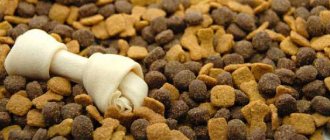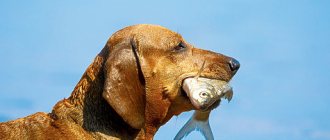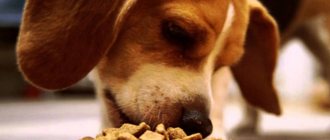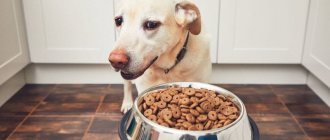Before getting a dog, you need to decide not only on the breed, but also on the upcoming costs of purchasing pet food. Correct calculation of a single serving is also important for the health of the animal, since overfeeding can lead to obesity, and excess weight, in turn, leads to other serious problems.
- 1 How to correctly calculate portions when feeding dogs
- 2 Frequency of feeding dogs
- 3 Diet by age and weight
- 4 Food standards for puppies
- 5 Food standards for adult dogs
- 6 Standards for natural nutrition
- 7 Feeding standards for wet food
- 8 Mr. Tail recommends: rules and regulations for feeding dry food (by breed, age, weight)
Three main principles in feeding a dog natural food
There are several postulates about natural feeding of a dog, which cannot be violated. Let's look at them:
1. Every breeder must remember that mixing natural food with purchased dry food is prohibited
Why is this so important? The fact is that when getting used to canned food or dry food, the dog’s stomach produces a certain amount of enzymes. In this case, switching to natural products will lead to indigestion and other serious digestive problems.
Moreover, if the stomach receives heavy food for a long time, for the digestion of which there simply is not enough enzymes, this can lead to the formation of putrefactive processes and the development of gastritis.
2. Daily porridge with pieces of natural meat is an inferior food
Some clarification is needed here. In addition to providing slow-release carbohydrates and fiber to give your dog energy and vitality, he also needs vitamins and minerals.
It is not possible to replenish their reserves through natural nutrition alone, so be prepared to supplement your dog’s diet with vitamin and mineral complexes. This will avoid vitamin deficiency, which means problems with your pet’s coat and health.
3. Before choosing a diet for your dog, you need to visit a veterinarian
Without a specialist, choosing the right food for your dog is very problematic. Based on the weight and age of your pet, the specialist will be able to select the type of feeding, and will also recommend a set of necessary products in the diet, taking into account the dog’s physiology. In addition, the veterinarian will recommend suitable vitamin and mineral complexes and tell you when to give them to your pet correctly.
Feeding prepared dry food
Of course you can feed your dog dry food. The main thing is to choose a quality product, check the integrity of the packaging, expiration date, and individual tolerance. The granules should be eaten with pleasure by the dog, not cause allergies, digestive disorders and meet the needs of the animal, which can only be judged after a certain time has passed.
Dry food is economical and convenient
Which food is better
Ideally, this should be super-premium or holistic food. They contain meat, grains, fruits and vegetables, probiotics, and the necessary complex of vitamins and minerals. Natural preservatives are used in production. Despite the higher cost, the consumption of high-quality feed is less. Premium foods contain low quality ingredients, but some of them are indeed animal products. Contain preservatives, large amounts of cereals, flour, soy and other ballast substances. Economy class food is made from low quality ingredients, usually food waste, soy, corn flour, which is not digested at all. Their composition is often poor in vitamins and microelements, and they also contain harmful flavor enhancers and flavorings.
How to avoid falling for manufacturers' tricks
Almost all advertised food belongs to the economy class, the differences of which are described above. Conclusion: don’t believe advertising. When choosing food, you should also not rely only on the relative protein/fat ratio, which is so often discussed on forums. For example, a product with the following indicators: protein - 35%; fat - 25% (which will be confirmed by an independent laboratory analysis) can be prepared from:
- 1 leather shoe;
- 1 feather pillow;
- 1 kg sawdust.
- 1 l. recycled motor oil;
It is not the percentage of protein that is important, but the indication of its origin. Any food has a composition, and the shorter it is, the better. Products are arranged in descending order. In the first place there should be meat, 1-2 types. If “lamb fillet” or “fresh kangaroo meat” is indicated - 35%, we remove moisture from it and in fact it turns out - 7%. Top of the list should be hydrated meat or meat meal with identified protein (chicken, lamb, rabbit, etc.). There should be no poorly digestible grains (corn, wheat, yam, sorghum). It’s even worse when there are several of these components. There should be no more than 2-3 types of croup. Preferably brown rice, oats, barley, whole grains. Grain-free foods are not suitable for everyone and may cause soft stools. Food industry waste is hidden under the names: cut, ground flakes, vegetable protein hydrolysate, gluten. By-products should be no higher than position 5. The food must contain oil (sunflower, flaxseed, salmon) or fat. A good plus will be the presence of sea fish meal, dried berries, herbs (rosemary, chicory, alfalfa), pre- and probiotics, as well as a competent selection of vitamins and microelements. The ratio of calcium and phosphorus is 2:1. The ash content of good food is no more than 7%. 8-10% indicates a large number of substances that have no nutritional value.
Class affiliation of dog food
- Holistics: Akana, Artemis, Canidi, Chicken Soup, Go, Grandorf, Innova, Original, Test of the Wild, Wellness, Almo Nature.
- Super-premium: Almo Necher, Artemis, Eagle Pak, Arden Grange, Fest Choice, Pronature Holistic, Bosch, Belcando, Nutra Gold.
- Premium class: Anf, Brit Care, Diamond, Eukanuba, Happy Dog, Hills, Nutra Dog, Yozera, Yoral Canin, Pronature, Original, Advance, Bozita, Brit Premium, Nutra Nuggets, Purina Pro Plan, Purina Dog Chow.
- Economy class: Chappie, Darling, Pedigree, ARO.
Rules for feeding dry food
The food should best suit the physiological needs of the dog: age (puppy, junior, adult, senior), size (dwarf, small, medium, large, giant), activity (domestic, active) and health status. Diets have been developed for healthy animals and dogs with various problems, but they can only be given after consultation with your doctor. Flavoring additives can be any: with fish, meat, chicken, the main thing is that the dog likes them.
The duration of feeding one diet is an individual matter. First of all, it depends on the age of the dog. For example, they switch from a junior diet to an adult diet at the age of about a year, and to food for older animals at the age of 8-9 years. However, it is also important to take into account the condition of the animal. It happens that a ten-year-old Spitz is much more active and energetic than a five-year-old Pekingese, then it makes sense to keep him on a “youth” diet longer. You should think about changing food if your dog is sick, has allergy symptoms, indigestion, or a change in appetite for the worse. There is no point in changing food if the dog eats it with pleasure and looks and feels healthy.
An equally important question is: how much should you feed your dog? The daily portion is calculated by weight, based on the recommendations indicated on the packaging. But you can slightly adjust it, reduce it, or, on the contrary, increase it a little if there is a clear lack of weight on your face (or rather, on your muzzle).
Pros and cons of feeding industrial feeds
Pros:
- No need to cook;
- Convenience (you can take dry food with you on a trip);
- Economic benefits (even high-class food is usually cheaper than a full diet of natural products). In addition, there is no need to spend extra money on vitamin and mineral supplements.
Minuses:
- Cheap feeds have minimal nutritional value;
- If the storage rules and integrity of the packaging are not followed, the food may deteriorate and cause poisoning of varying degrees of severity;
Table of foods recommended for feeding dogs
Let's move on to the table of products recommended by the international BARF nutrition system for animals:
- Raw meat : lamb, horse or beef, chicken, turkey and rabbit meat. The presence of cartilage, films and veins is allowed in the meat.
- Bones : beef tails, bird heads and necks (necessarily without beak).
- By-products : heart, brain, lungs and tracheas, beef trimmings and poultry offal.
- Fish : river and sea fish. Sea fish (cod, mackerel, halibut and others) should be a priority, because... it has the highest content of phosphorus and Omega-3 fatty acids. It is best to give your dog fish food twice a week.
- Vegetables : broccoli and cauliflower, carrots and zucchini, cucumbers, pumpkin and bell peppers. Vegetables can be given either raw or boiled.
- Greens : parsley, lettuce, seaweed and dandelion leaves.
- Berries and fruits : bananas, apples and pears, blueberries, blueberries and watermelon. This food can be used as a treat.
- Eggs. It is recommended to give dogs exclusively egg yolk, no more than 1-2 times a week.
- Fermented milk products : cottage cheese and kefir, natural yogurt and yogurt.
- Oils : burdock, linseed and olive oil.
Important! There should be equal amounts of bones and meat in a dog’s diet. It is advisable to feed your dog these products raw.
Important! If your pet refuses raw vegetables, try boiling or stewing them a little. Perhaps then your pet will like them.
Bones are best given raw.
Important! The BARF system does not recommend feeding your pet cereal. However, if you do not want to strictly adhere to this system, you can sometimes give your pet boiled pearl barley, buckwheat or rice.
What affects the amount of feed?
First of all, the amount of dry dog food depends on the characteristics of the animal itself. Equally important is the caloric content of the feed and its saturation with fiber, fats and carbohydrates, as well as other nutrients. Here's what you should pay attention to when calculating the amount of food for your pet.
- Age
Puppies should be fed more often and in small portions, adult dogs - less often, but the portion size should be larger.
- Weight
The amount of dog food varies based on this indicator: the more the pet weighs, the larger the portion it needs for satiety and energy.
- Size
Large and small dogs need different amounts of food, so their feeding standards are different.
- Breed
Great Dane dogs, for example, need ten times more food than a Chihuahua.
- Mobility
The amount of food consumed increases in dogs that lead a very active lifestyle. When running, playing and hunting, a pet spends a lot of energy and needs to replenish it through food.
- Health status
The serving size and frequency of feeding dogs dry food may vary depending on the health of the pet. A sick pet may need more nutrients for speedy recovery and recovery.
- Calorie content of feed
The caloric content is indicated on each package - usually the number of calories is indicated per 100 grams or kilograms of the product. Thus, the portion of high-calorie food must be precisely adjusted so that the pet does not overeat, and low-calorie food so that it can be properly satisfied.
Rules for feeding your dog natural food
Now let’s get acquainted with the basic rules of feeding your pet natural food, which every owner should know about:
Important! Some dogs may develop food allergies. In this case, it is worth finding out which product is allergenic and choosing a replacement for it.
Nutrition for a pregnant dog
Pregnancy for a dog is a difficult period not only for the pet, but also for the owner. The owner must take care to maintain the health of the pet and her future puppies. This can be done by properly adjusting your diet.
At the beginning of pregnancy, your dog's appetite may completely disappear. This is a normal reaction of the body. Refusal to eat may last for several days.
A dog's nutritional needs change during pregnancy, but not radically. Until the 5th week of pregnancy, the feeding schedule remains the same. In the future, the owner should increase the portion of food by 10% every week. This will be enough to replenish nutrients and energy.
During pregnancy, you should not give additional nutritional supplements unnecessarily. An excess of certain substances (for example, calcium, phosphorus) can negatively affect the development of puppies and the well-being of the pet itself.
During the last weeks of pregnancy, your dog may have difficulty eating. The favorite is not immune to digestive problems. In this case, the owner should switch the dog to high-calorie food. Portions will be reduced, but calories will enter the body in the same quantity.
During the entire pregnancy, the dog should gain no more than 30% of its weight. To prevent the development of obesity, it is recommended to weigh your pet weekly.
How many times a day should you feed your dog?
The frequency of feeding your pet is determined by his age. For example:
Bone is an excellent trainer for proper jaw development
The daily food intake depends on the age of the animal:
Norms and meal times
A domestic dog, like a wolf, is capable of absorbing 1/5 of its own weight in one meal. A dog's stomach can stretch significantly. But a domestic dog does not live like a wolf, which feeds for future use until the next prey. Therefore, the owner must monitor the diet and calorie content of the lunch consumed, since all dogs eat quickly, without noticing their stomach is full. According to veterinary statistics, about 20% of domestic dogs aged 1-4 years are overweight.
When an animal ages, it is fed the same portions as before, only the caloric content of the diet is reduced. Large individuals require more food to be full, but to prevent obesity, they also deliberately reduce the caloric content of portions.
An important condition: next to the food bowl there should always be fresh water in direct access around the clock. If the dog is young or has to work or train a lot, the volume of food is increased accordingly. This applies to service dogs, hunting and sledding breeds.
It is better to give food according to a schedule at certain hours, or according to a schedule established by a veterinarian in individual cases. As a rule, pets are fed in the morning at 7-8 am, and in the evening, at 19-20 pm.
How much food does your pet need?
This dry food can be fed according to the instructions on the package depending on the weight of the dog. But natural food needs to be selected, and for this you will have to watch your four-legged friend for some time.
In general, the proportion of food in the diet should be as follows:
Important! Neutered dogs often have the problem of obesity. In this case, the owner should reduce the amount of cereals (carbohydrates) in the diet and increase the amount of vegetables (fiber).
If your dog immediately eats everything that is put in the bowl, and also licks it, he probably does not have enough of the offered portion. Try increasing the amount of food a little next time. When, half an hour after feeding, there is food left in the bowl, most likely you have exceeded the norm. Try reducing it at your next feeding.
Important! Until you establish a food allowance for your dog, keep an eye on his weight. The fact is that many dogs are prone to gluttony, and by increasing the portion size, you risk causing your pet obesity, problems with the spine and cardiovascular system.
Important! If there is a need to lose weight for your dog, reduce the portion and increase physical activity.
Food standards for adult dogs
The amount of food per 1 kg of body weight per day for an adult dog depends on the breed and weight:
| Breeds | Number of calories (kcal) |
| Dwarf or very small (up to 5 kg, height up to 30 cm) | 100-120 |
| Small (from 5 to 10 kg, up to 40 cm) | 55-95 |
| Medium (up to 20 kg, 40-56 cm) | 70-80 |
| Large (from 20 to 30 kg, 56-65 cm) | 60-70 |
| Giant (50+ kg, from 60 cm) | 55-65 |
It should be taken into account that the animal may have food allergies.
Dogs over 7 years old are considered senior dogs. Due to their age, they may experience problems with their digestive system. If the diseases are pronounced, it is recommended to transfer such individuals to a special diet.
If, due to its age, the animal is obese, then, as a result, the following may occur:
- joint inflammation;
- disruption of the cardiovascular system;
- hormonal imbalances and changes;
- occur: diabetes, heart failure and arthritis.
Foods that are prohibited for dogs
There are a number of foods that should not be included in the diet, because... they cause obesity or provoke gastrointestinal problems. Let's look at them:
Fried foods with lots of spices irritate the stomach
Some owners wonder: is it possible to feed a dog soups? In fact, soups will not bring your pet much benefit, nor, by the way, harm.
Berries and fruits are natural vitamins
Is it possible to soak food?
Up to 3 weeks, the puppy eats only mother's milk, which has a liquid consistency, so there is often a need for an intermediate stage between it and solid food. Some owners prefer to start feeding their pet more mature food, soft purees and pates.
If the choice is immediately made in favor of feeding the puppy dry food, but it is difficult for the baby to chew it, it is allowed to soften the granules with plain water or boiled cow’s milk at first. The easiest way is to add a small amount of warm liquid (40-50°C) to the measured portion 20-30 minutes before meals. You should make sure that the hard pieces have time to get wet, and the consistency begins to resemble puree. Sometimes dry food is ground up before liquid is added to it.
Expert opinion
Anna Abramenko
An avid dog lover. Experience in veterinary medicine since 2009.
Ask a Question
The older the baby gets, the less water and milk needs to be added. Usually for a 2-3 month old puppy this is not necessary - he chews dry food confidently.
The portion of soaked food looks larger than dry food, but there is no need to reduce it. It is unacceptable to fill granules with liquid for future use: they quickly begin to deteriorate and are stored for up to 3 hours in a warm place, 12 in the refrigerator.
Approximate dog diet for a week
So, having decided to feed your dog with natural products, you can use the following scheme:
1. Morning feeding
Ideally, fermented milk products (kefir, cottage cheese, yogurt, sour cream) with the addition of porridge are suitable for the morning. It is advisable to add vegetables to the porridge.
2. Evening feeding
In the evening, your pet should be given meat with porridge. You can also add vegetables and fruits. Once or twice a week, meat should be replaced with fish.
Twice a week you should add the yolk of a chicken egg (or two quails) to the meat. Also, at each feeding you should add a little vegetable oil to the food.
A straight dog may not look very appetizing to a human.
Before or after a walk?
It has been noted that active walks within half an hour after eating are one of the risk factors for gastric volvulus. This is a very dangerous condition that requires urgent surgery, and without treatment leads to the painful death of the animal within a few hours. Representatives of large breeds are especially prone to gastric volvulus. Therefore, the general rule is to take your dog for walks before feeding.
However, if the puppy has not yet developed neatness skills, he will have to be taken outside after eating. It is at this time that he has the desire to “go to the toilet.” The main thing is that the walk with a full stomach is calm and short. When the puppy matures and understands what's what, gradually adjust to feeding after walks.
How to cook dog porridge with meat
From experience, we can say that for proper nutrition, you need to feed your dog porridge with meat 2-3 times a week. Pearl barley, oatmeal, and wheat porridge will bring benefits, but buckwheat is the most beneficial. It contains many useful minerals, and besides, it helps the dog lose weight and cleanses the circulatory system.
Therefore, next we will describe the process of preparing buckwheat dog porridge. Preparing such a dish is not difficult. In the evening, pour cold water over buckwheat and leave overnight. To cook porridge, you will need to take 1 part buckwheat and add 2 parts water. This porridge is cooked for 15 minutes, after which it is infused in the pan for the same amount of time.
During the cooking process, you can add chopped meat to the porridge. Before adding to the porridge, the meat must be boiled to prevent possible infection of your pet. The total volume of meat should be approximately 1/3 of the volume of porridge.
Many dogs love to crunch on cucumbers.
As for additives and seasonings, it is advisable to avoid adding salt to porridge, but a teaspoon of vegetable oil will be very useful.
Establishing a regime
Building a daily routine begins after the moved animal has completely settled into the new place and gets used to the surrounding environment. This usually happens one to two weeks after the move.
Having a clear schedule makes life somewhat more difficult for the owner, but it also has advantages:
- Strict alternation of nutrition and physical activity eliminates the possibility of obesity and allows you to maintain good physical shape.
- Just make a menu in advance and make sure you get all the products you need for a healthy life. This is especially true for natural pets.
- It is easier to control natural urges in puppies. You know exactly when the animal will need a walk to perform its toilet duties, which means fewer unpleasant surprises await you.
- A clear routine can save lives. As soon as the pet remembers when it is fed daily, it stops picking up all the food available to it on a walk, because it knows that it will definitely be fed after a while. This means that the chance of being poisoned by something spoiled or deliberately scattered by dog hunters drops sharply.
- Attempts to bite and constantly beg for food from others disappear. This habit is found either in very spoiled dogs or in children who are gradually switching to fewer meals. But over time, the animal gets rid of this habit, which means the threat of gaining dangerous weight also decreases.
A clear arrangement of a pet’s daily life schedule depends only on the desire and capabilities of the owner. There are several rules that will make your dog’s life more comfortable and will help you carefully weave new responsibilities into a person’s usual rhythm of life:
- Analyze your life cycle and determine once and for all when is the best time to feed. Keep in mind that a puppy and a pregnant bitch require more feedings than an adult dog during a normal period.
- When deciding at what time you will provide food, consider physiological needs . The dog will want to relieve itself 20-30 minutes after feeding, and will also need a walk after 6-8 hours, provided that the digestive process is normal.
- As soon as the animal matures (usually this happens by the age of 2 years or a little earlier for representatives of small breeds), he will learn to tolerate several hours, but it is still better to accustom him and yourself to a walk immediately after breakfast, because pregnant, sick and old dogs cannot be tolerated. can, which means that when the status changes to a similar one, the pet will experience psychological discomfort due to its behavior.
- Accustom to a clear daily routine gradually and do not change it. Walking and feeding should be timed from the first weeks of the dog's stay in the house. However, the dog itself will get used to the established rules only after 6-7 weeks of observing them. If you yourself regularly break the routine, the animal will never be able to get into the rhythm.
Conclusion
Natural nutrition is as close as possible to the dog’s diet in its natural habitat. Therefore, if you have the time and desire, you can always create a balanced and healthy diet for your pet, which will be the key to your dog’s health and longevity.
By the way, if you decide to switch your pet from natural feeding to dry food, you need to do this gradually, over 10-14 days. At the same time, during the transition period, probiotics should be added to the dog’s diet daily.
Why is underfeeding bad?
If exceeding the norm threatens obesity, then what is wrong with underfeeding? A deficiency of nutrients that the dog does not receive from the daily diet will have a bad effect on the dog’s health - the animal’s bones and internal organs will suffer. This is especially true for pregnant and lactating bitches. Underfeeding is dangerous for a puppy or a bitch that has just given birth.
During the period of feeding puppies, the feeding rate is increased - in this case, the food can be left in the animal’s bowl without restricting it. Even if she eats 200% of her daily allowance, that's okay. Malnutrition threatens not only the deterioration of the health of the mother with a tail, but also of the puppies, since the quality of milk decreases.
Important: if during the feeding period the bitch cannot eat a lot of food, and she loses weight, it is worth consulting a specialist. It would be better to switch the animal to a higher-calorie type of dry food.
Problem situations
An improper diet affects your dog's health. Let's look at the most common problems that may arise.
To establish an accurate diagnosis, consultation with a veterinarian is necessary!
Dog poisoning
Here is a list of symptoms that may indicate poisoning:
- pain;
- moans;
- rapid or difficult breathing;
- vomit;
- diarrhea (sometimes with blood);
- convulsions;
- weakness.
If you have a food allergy, it is better to give activated charcoal or a weak solution of potassium permanganate before the doctor arrives. If your dog is poisoned by non-food substances, do not self-medicate, because even potassium permanganate can cause harm.
Before visiting the veterinary clinic, analyze the dog’s behavior and what it has eaten recently.
Digestive problems
Bloating and volvulus can occur in an animal, regardless of its breed. Following the recommendations of veterinarians will allow you to properly care for your pet’s health.
- Should you feed your dog before or after a walk? You should not go for a walk immediately after eating. Wait 3-4 hours or walk on an empty stomach.
- How many meals should there be? An adult dog only needs to eat once. Set aside a specific time and stick to the routine.
- What foods can cause bloating? If you feed your dog natural products, exclude cabbage, legumes, and milk. If you are feeding commercial food, try changing the brand or switching to a higher quality food.
The dog refuses to eat
Even if you have properly organized the feeding and walking regime, a problem with loss of appetite may arise.
To determine the true reason for refusing to eat, contact your veterinarian. Self-medication can lead to complications or death of the animal!
- Psychological atmosphere. Analyze the dog’s behavior, which could cause a sudden change in mood: change of environment, stress.
- Damage to the oral cavity. It is not uncommon for a dog to refuse to eat if its gums, tongue or tooth are damaged. Examine the mouth for wounds.
- Changing food or bowl. Perhaps your dog does not accept the new food or does not like some product.
- Disease. If the animal looks weak or lethargic, it is necessary to urgently contact a veterinary clinic, since loss of appetite often becomes a symptom of various diseases.
Following simple rules will help you organize proper care for your beloved dog and protect it from disease.











